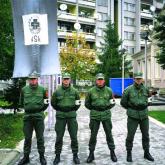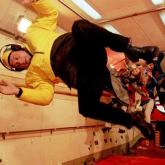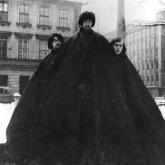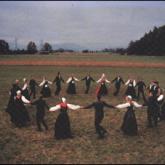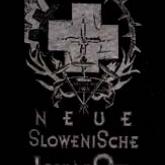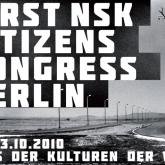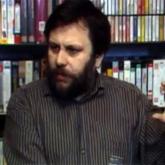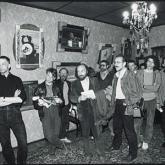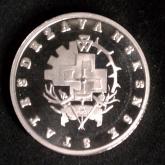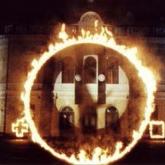Week 51: IRWIN
Hi Everyone,
This Tuesday is another event in a year-long series of weekly conversations and exhibits in 2010 shedding light on examples of Plausible Artworlds.
This week we’ll be talking with Miran Mohar, founding member (with fellow artists Dušan Mandič, Andrej Savski, Roman Uranjek, and Borut Vogelnik, who may also skype in) of IRWIN, a collective of Slovenian artists, primarily painters, which would become the visual-arts wing of the broader collective Neue Slowenische Kunst (NSK).
http://www.nskstate.com/
http://en.wikipedia.org/wiki/IRWIN
http://times.nskstate.com/tag/irwin/
IRWIN was founded in 1983 by a group of guys from the punk and graffiti scene in Ljubljana, who decided to call themselves Rrose Irwin Sélavy. The name of course is a wink to Marcel Duchamp, who used “Rrose Sélavy” (pronounced, tautologically, as éros c’est la vie) as one of his feminine pseudonyms. The group subsequently shortened the name to R Irwin S. In 1984, the group co-founded a larger collective known as Neue Slowenische Kunst (NSK), with like-minded artists from other fields, including the rock band Laibach, and the Scipion Nasice Sisters Theater group. NSK’s modus operandi was what their contemporary and compatriot Slavoj Zizek has called “over-identification”: that is, rather than critiquing powerfully connoted political imagery (including Soviet, fascist, religious and Suprematist images), they would endorse it to an excess, to considerable traumatic and provocative effect, engendering confusion that could only be resolved by acknowledging that no space, no frame — no world of interpretation — is neutral. In some ways, it was a particular, post-Yugoslavian brand of institutional critique; but the insistence on collective, depersonalized production, pushed IRWIN and NSK as a whole in the direction of imagining alternative forms of political communities, including the project “A State in Time”, which led to opening embassies and consulates in Moscow, Ghent and Florence, issuing NSK passports to “citizens” who have used them to cross borders.
More recently, IRWIN has developed the large-scale, open-ended cartographic project “East Art Map” (presented at Basekamp in 2006), one of the most ambitious attempts to map the vectors of influence and development of conceptual art in the countries of the former Soviet bloc — reappropriating a history and horizon of aspirations and production, challenging the hegemony of the Western art-historical canon. With humor and meticulous detail — not to mention some beautiful maps — IRWIN has shown the importance for any plausible world to be able to map its trajectory. The group refers to this approach with the paradoxical term “Retro-avant-gardism”, drawing attention to the temporal provincialism inherent in conventional art history with the 1987 statement: “The Future is the seed of the past.” With one week left to go in our year-long cycle of discussions, and before Plausible Artworlds morphs into a new project, what could be more important to address than that performative paradox?
Transcription
Week 51: IRWIN
Miran: Are you at the hotel or at the airport or in the city?
Stephen: I'm in, what do they call it, the food court at the airport.
Miran: O my God.
Stephen: Yeah it's a complete American concept. You got to see it to believe it.
Miran: Yeah.
Stephen: Here I am and it's great to talk to you.
Miran: Great. Great to talk to you again yes.
Scott: So that's really fabulous I love that you're at a food court Stephen. So hi Miran welcome.
Miran: Hi.
Scott: Welcome to one of our weekly chats. The second to the last in this year of discussions about what we're calling Plausible Artworlds. And welcome everybody. Tonight we'll be talking with members of Irwin and NSK represented by Miran Mohar. And yeah I know would give a lengthy introduction but Miran instead I was wondering if you would be into describing Irwin for people that might not know. And don't feel like you have to give a formal presentation but if you wouldn't mind just giving us a brief intro.
Miran: Okay so how much one, two minutes or something like that more?
Scott: Well you know just I thinkÖ
Miran: Okay.
Scott: ÖI think it might be worth saying what we're ñ yeah let me paste a description by the way for everyone so you can have a slightly more lengthy introduction. I just pasted it into the fact. And for people listening later it's one of the links right on the Basekamp Web site to Irwin under Plausible Artworlds. But I think it might be worth saying what we were just reiterating what we were most interested in. And you can talk about anything you want but I think what we really want to see or look at is to look at Irwin and NSK as a kind of prototype for a different kind of artworld.
Miran: Okay.
Scott: And so we'd really like to know about how you guys, like kind of a little bit of the why, a little bit of the context maybe. But also at some point it would be great to get into the structure of how you set everything up and all of that.
Miran: Okay should I say a few things also about what NSK really is and a little bit of history? I mean if this is important I could do that as well.
Scott: That would be great.
Miran: Okay. Tonight we just start this for the people who don't know anything about it. I'm a member of the collective [inaudible 03: 46] which is a group of five artists, five painters and we work together since 1983. And it is also part of the wider structure which the beginning was called Mia Slavenish Securs. Later in the end of '80s changed the name to Accu Namaniska. And the group was founded in 1984 and consists from the group Laibach started much earlier, basically the beginning of the '80s; 1980.
And this is the group which was mostly in the field of music but they also started in a wider field of ours. They also did visual arts in the beginning. Then Bob Densky was also theatre group a CPO analysis and designed studio collective, later on joined the Department of Pure Practical Philosophy. And we also have a television department architecture but just for a very short time. So basically the group, each group was serious with the [inaudible 05: 15] Charter but from time-to-time we agreed ñ can you hear me?
[Background noise]
Stephen: Yes. Can everyone please mute their mics when not speaking?
Miran: Something is ñ hello.
Stephen: Yeah give us just a second to sort out the - okay is that better?
Miran: Yeah. But I don't see others, are the also others on line?
Stephen: Yes there are 1, 2, 3, 4, 5, 6, 7 people on the channel.
Miran: Okay. So just to continue each group was from the beginning completely independent but we had some kind of common ideological background for certain things. But we have been also very different and we still are. So the NSK so first different first group agriculture and in the beginning of the '90s in 1992 it got switched from organization NSK to the State in Time in fact. So speaking of Irwin it's getting very much with contemporary art today about ideological elements in art itself. And especially we have in interested in the conditions of art and production of art, at least in Europe, and we did many project related to this issue and this field. NSK State in Time was kind of initiated by [inaudible 07: 29] being the buddy and NSK Embassy in Moscow in 1992. And other NSK groups accepted this also as a platform to their own activity.
So just recently we had a conference of the NSK Citizen in Berlin this was in October and at the moment we're working on three of them covering the Congress. And we also lately do an exhibition related to the NSK In Time which one of the Soviet's still own in the city near [inaudible 08: 14]. This was very, very brief introduction and I think it's better maybe if you just Scott or Stephen ask me some questions you think that could be interesting to the public and then speak more to your ñ yes I hear you.
Stephen: Miran I have about 2000 or 3000 questions so let me start with a really basic one. I think it's the first time in our yearlong series that we've talked to people who self-described as a group of painters. You didn't say we were a group of artist you said we were a group of painters. Could you elaborate on whyÖ
Miran: Yes.
Stephen: Öyou say that?
Miran: You know what I would say we studied painting because the academic academy in Vienna was a quite conservative 19th Century institution and we studied painting what's what our profession. And our diploma it's written that we are painters actually. So of course today everyone is using many people is using, especially just being an optimist. So we are just professionally we are painters. Of course we have been working now also in the media but primarily our education it's based on the practice of paintings.
Stephen: And painting continues to be an important practice where you find.
Miran: Of course all the time yes. All the time. All the time is a kind of red line from the beginning yes. So we started our first even exhibition ever paintings of course yes.
Stephen: I think particularly a line with the Su'prematist movement. There seems to be sort of an ongoing relationship with engagement with Soviet Su'prematism, Malevich and so on. Am I right about that?
Miran: Well yeah. Malevich Su'prematism was, let's put it this way, important part it is an important role even in practice but it's not the only one, it's one of them. Our paintings many times the multitudes are taken from I would say modern Su'prematism then also for totalitarian style conceptual app and so on. So you have a very wide I would say, very wide space. Also we are taking material from I would say Alpinean culture and motifs which are around s basically yes.
Scott: You know Miran would it be okay to talk a little bit about Irwin NSK's overall approach to embracing or just adopting a kind of access. Stephen wrote a little bit about it in this introduction and I know other people have written about your approach. I'm asking that because you're talking about motifs and to the casual, well to someone who might not be familiar with work it might sound as if you're just representing things.
Miran: Yeah okay. I would tell you maybe I can answer you like this I'll explain to you. I mean the motifs we are using in our works this is not based on the identification with these motifs it's not this kind of equalistic perception. For instance, we do [inaudible 12: 32] now and sometimes we would have a deal but we don't believe in deals of course you know. I mean we don't believe in deals. So basically what is important in even most relations between certain motive constellations and such and such isn't, so basically what is important is not what you see. Basically for instance we don't paint it here we think that motif is such a glamorous strong motif but it is a point of preference. It's just like something what is around me and it is never did itself.
We have for instance one of the paintings on the abstract painting. So it's always the motive for doing the relationship with the background. So in our work it's the view is the one who kind of at the end propose his own story.
Stephen: Do you have any images you could send us to a link? Actually I didn't find a specific Irwin Web site I found the NSK site I found reference to Irwin. Maybe it would help some people to see some pictures of what you do.
Miran: Yeah I must say that I'm very bad to describe so I have to say I could add things from my computer if somebody explained me how this works.
Scott: Yeah Miran. So let's see here. Do you see the chat where Stephen was just the last person that typed in?
Miran: I haven't checked your HTP ñ yeah, yeah I see this one. Yeah the check, yes, yes.
Scott: Yes and Stephen just checked in the motive of the [inaudible 14: 35] important dot, dot, dot. So if you write a littleÖ
Miran: Just the motives are very important. Just a moment I go down. Yeah I see it yes, yes of course.
Scott: Okay. So if you scroll all the way to the bottom and leave it at the bottom it will continue to automatically scroll for you whenever someone types in and you can just copy a link from your browser and paste it right in there and hit enter, return.
Miran: Okay but basically we don't have specific areas inside so maybe yeah I could send the link to the ñ okay I look at the web here our gallery site yes.
Scott: Okay.
Miran: There's some works. Just a moment.
Scott: Okay.
Miran: Yeah.
Scott: And here are a few links that we already have.
Miran: Just a moment. I'll send you the link yeah because ñ just a moment. Okay this will work yeah I'm sure. This is fine. Okay. I also have yes. So here on this link here which is a [inaudible 16: 11] you can see some of your work, some of your paintings and the latest paintings of monochromes is also one of his dear and okay. I have a question Scott, can you hear me?
Scott: Yes.
Miran: If here I have a command to send file so here I can attach a small image.
Scott: Yeah if it's not too large it'll go through Skype really well.
Miran: No it will be small maybe I'll attach one here, yes okay.
Scott: Great.
Miran: One or two in just a moment.
Scott: Okay.
Miran: Just a moment. Okay.
Scott: Okay that's coming through.
Miran: It's coming through. This is a typical a little icon namely a painting a mileage between two wars and probably it's three handed car or something.
Scott: Yeah it's almost here.
Miran: Yeah.
Scott: Oh really. If anyone can't see this we can upload it to the Web site.
Miran: Do you see it?
Scott: Yeah we do here.
Miran: Okay.
Scott: Would anyone like us to upload this online somewhere? Anyway if so just let us know and we can upload it.
Miran: I don't know how this works. You probably see a ñ okay so I can say something about, for instance this two works. The first one which is called Irwin Icon A this is called Mileage Between Two Wars. In fact on this painting you'll see basically two female portraits, you'll see the mileage to cross it and you'll see basically the two statutes, which looks very Nazi because they are before the Nazi. They are from the first German, the first World War in fact. And basically it's a kind of sandwich you see that the image of Su'prematism is in between realism.
And then on the second one you see, as I said before you see the deal on the account objective the fine abstract paint I mean this example from '85 or something it's earlier in the room basically. Okay any questions?
Stephen: Yes I have a question.
Miran: Yes.
Stephen: It's a very strange aesthetic that you have. It's a very complex ñ remember when I went to see Live Box the band for the first time it was also very strange experience for me because it appeared to be fashionable but it wasn't obviously. I think it's what [inaudible 20: 33] refers to over identification.
Miran: Yes.
Stephen: Where did this come from? How did it happen a whole bunch of the graffiti arcade and from the street arcade and from sort of political theatre and really hardcore sort of heavy metal rock all came together as really hard aesthetic? Can you say a few words about the biggest reflex aesthetic project?
Miran: Yeah that's basically I would say over identification it's just not something what was just started was on a scale live zone it was already on the scale before but I would say that through live [inaudible 21: 21] accelerated. So I mean it's so connected to the crisis of language. For instance, with this kind of politicalistic language when you are saying that you are expressing will not express themselves in a positive language. And then basically the meaning comes out a little twisted because first of all in Yugoslavia the Communist Party called names and say I want to get out of the working class.
So the space of the Avengard was already occupied so you could appear only as retro Avantgard. And basically this over identification matter was how to say it was more for that too because the viewer had to construct his own meaning. And you should care for things; you should follow all these things carefully. As usually would say except of the aliba, they are not the answer, they are kind of question marks. So the public it is true that we said Stephen that when public come they were confused they said "What is this? Is this like a ñ there's something odd about it, something to reiterated not just some but anyone who go closely to the content or to analyze these it was clear that this is not artistic, they're not artistic elements. But basically using this method of over identification was very, how to say purpose to make the public the older thing. Hello.
Scott: Hey yeah we're here. I think everyone's just listening. Yeah I am ñ this was one of the most interesting things to me about all of this when I first found out about your work when I first learned of you.
Miran: Yeah.
Scott: I think it was also very I think very interesting from a I want to say, well from a western perspective, because there is well our version of over identification was kind of like Andy Warhol's kind of embrace of capitalism but it's something very different I think what you guys were doing. You're not really ñ I mean you are using art historical imagery but you're not really making art about art really. You're always occupying a position of artist; well you're using the role of yourselves as artists in order to look at other things.
Miran: Yeah. I mean basically we do have very different roles in NSK. The liable politicians of that era is the chronist like painters who are doing like chronical somehow, commutation whatever you want to call it, and to see if they're presented the ritual, the religion. So we have very precise roles in fact. And basically even when lately it's not as much connected with over identification. It is to a certain extent but it's also very much interested in the deal of construction to construct our own reality our own conditions. So the [inaudible 25: 52] has this meaning and also how we deal with the issues of the artist in Eastern Europe it's very much about art. And of course through that it's political through art not through language or the political you know, or daily politics let's put it this way.
Greg: Miran this is Greg at Basekamp. I'm wondering if there's some discussion on the chat in regards the context that your work is, within the context of your work as its specific to your geography, your location. I was wondering if you could talk a little bit more about how the work is received locally in Slovenian and how it's sort of perceived around the globe.
Miran: Yeah.
Greg: Because I know sometimes those things can differ.
Miran: Of course, of course. No, no I can tell you and you just stop me anytime if I'm going in the wrong direction or I didn't understand the question, basically the perception of course NSK, and not only NSK all the groups that I have [inaudible 27: 02], was very different from recent, especially Eastern Europe or Western Europe in America. For instance when you go to Moscow immediately understand what we're talking about. So they immediately understand the humor in the live box or NSK work or so on. While for instance in, I don't know, Germany training then [inaudible 27: 27] matter is it you know.
While I think also in the United States things were very different because people were not familiar that much with certain [inaudible 27: 41] and so on and society was very differently organized and so on. So yes I mean basically our concept never, I mean we never used this kind of ironical moment on the first, let's put it this, we were not ironical on the first side so everything on the first layer was did the serial. When you go more inside you could reach other layers and so on. So basically of course it was a lot of misreading and misunderstanding and a [inaudible 28: 22] but we knew that this would be part of it. So basically we would have people all the time pro contra and basically for the most of the people it's clear that the totalitarianism in 20th or 21st Century would not appear on this way. I mean the totalitarianism and the uprising of fascism on all this more contempt reform, in fact much more liberal reform.
Greg: Thank you Miran that was good.
Miran: For me it's basically because I'm not that good in English it's really difficult to talk and read all the chat. So if there's any interesting question or questions anyhow just repeat it to me by voice and I will answer so.
Greg: Yeah, yeah no I was just sort of picking out parcels of the discussion and thought I'd sort of try to frame the question on that.
Miran: Yeah.
Stephen: What I'm trying to do Miran is trying to run a commentary going on what you're saying as well so we'll have a textual trace of all of this. I was very ñ a few minutes ago you talked about politics through art. You don't do direct political action, you don't see yourself as a political activist.
Miran: No.
Stephen: And you don't just do art either. But it seems to me that one particularly emblematic example of your work is that east art map projectÖ
Miran: Yes.
Stephen: because that is something specific art competence to try and repossess a history from which artists, and particularly concept artists across the eastern part of Europe former socialist countries had been written out of history and they wanted to write themselves back in, in a certain way.
Miran: Yes.
Stephen: And that's successful both politically and art historically. So it'll really be great if you talked about that, particularly as I think you showed that or at least part of it at the Basekamp space.
Miran: Can you hear me?
Scott: Yep definitely loud and clear.
Miran: Okay. So I will talk a little bit about it yeah. Basically the Eastern Art Map definitely it's a very ñ on the flipside it's a very I would say almost traditional project. It's nothing else than like the eastern of the artistry. But at the same time because there is no such thing so the history of contemporary art in Eastern Europe for different reasons. I mean for the reasons that the art history only exist in the countries which possessed follow to create history. I mean history's always constructed. I mean these countries are countries which have developed a system or they have an old tools which our system is made of like the museum collections, collectors, artistic and basically there is no such things in Eastern Europe. So basically we only have kind of local methodologies about it.
So just the idea the history can or at least elements of the history can be created. It has some political indications in fact because basically to explain to you if you are an artist living in Eastern Europe and you are living in a space where the art system does not exist or exist in a very basic element then you cannot only be just artist you have to also create your context with it. And Eastern Map is just one of quite complex project where we try to create a context for ourselves. I mean if you do art this art has to be part of some kind of stories, some kind of miracle. And basically we just reach this position of ourself not trying to criticize maybe worse or whatever that artist from east are not included in these but because it's not productive. The most productive thing is and still believe that you start to create your own context, you start to create your own elements of your art system, and that's what we did with the Eastern Art Map project.
I don't know maybe Stephen should I go more into details about what it is what this project was or?
Stephen: In my opinion it's crucial to talk about it because what you just said there is extremely important right that if you don't have a context you don't have any art. Yes and you can make things ñ you can still political images until you're blue in the face you can show people starving to death and people hitting other people over the head with guns and you're not doing politics, and you're not doing art you're not doing anything at all because there's no context. And what's interesting about the Eastern Art Map is it's sort of you've created a context where there couldn't be one. So I think it would be good if you just grabbed the whole process.
Miran: Yeah it's fine with me. So basically I would say that Eastern Art Map was just kind of a thought of the ice mountain iceberg. Iceberg of urban project which we started in the late 80s basically, beginning of the 90s and we ended it somehow with Eastern Art Map. At the beginning of the 90s in fact at the end of the 80s when the Berlin Wall fell down many people ñ do you hear me?
Stephen: Yes.
Miran: Yeah many
[Audio ended abruptly]

